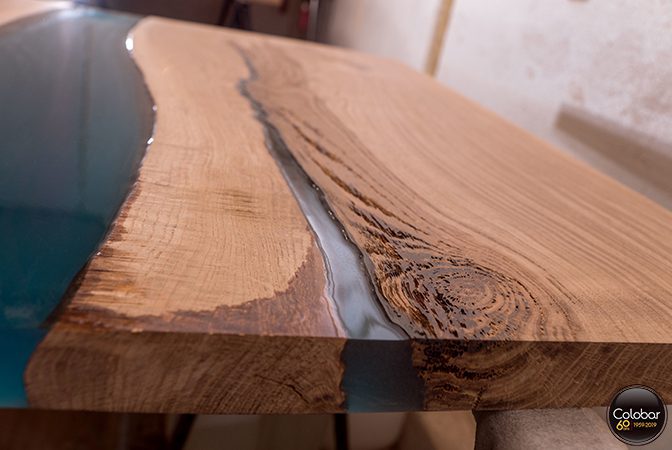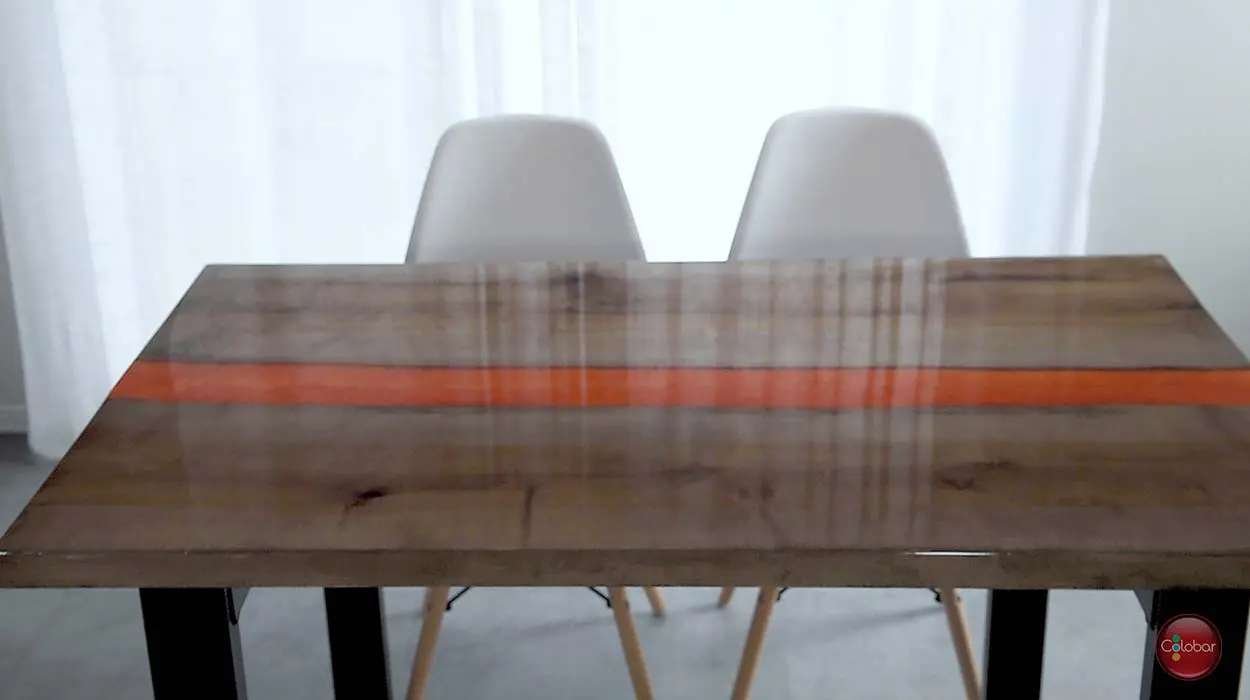November 28th, 2019
Daniel Geoffroy March 4th, 2019
Making an epoxy cast river table is a project that many do-it-yourselfers want to do. To carry out this kind of project, it is important to understand the principles related to epoxy casting. I will share here the tricks of the trade to succeed a beautiful wooden and epoxy table.

Practice first on a small model
My first advice is to undertake a small project before embarking on a big adventure. A small side table, a bedside table or a decorative tablet are examples of small projects to realize in order to develop your experience.

1. Epoxy river table: it starts with a good waterproof mould
First, you need to build a waterproof mould. It must be made of a strong and smooth material. Normally, melamine is a material of choice. It must be perfectly sealed since the epoxy casting is particularly liquid. Your mould could be drained of some of its contents if there is even a small open joint. When I build my moulds, I use Lepage “No More Nail” glue to fix the edges. Once assembled, I seal the inner edges with a micro-joint (very thin) acrylic caulking of clear silicone.
On the outer joints, I apply red tape “Tape Isoclad” therefore making sure there will be no loss of epoxy.
2. “Grease the mould” to help with unmolding the epoxy
Although melamine is not porous, the epoxy moulding is very adherent and tends to stick as it hardens. I highly recommend coating your mould with an aerosol release agent. This will greatly facilitate the unmolding in the end. Instead of the release agent, you can also use carnauba (Carbamex) furniture wax*.
*After testing, we noticed that Carbamex wax works best on a mould.
3. Prepare the wood pieces
Pieces of wood to be incorporated into the epoxy must be clean and free of friable bark. To minimize the risk of bubbles, it is important here to completely seal the wooden portions in contact with the moulding epoxy. Especially the board tips, the thickness and the portions with knots or beginnings of branches. The wood contains air. This air is likely to escape when the piece of wood is heated for many hours by the epoxy that has been poured.
The best way to seal the pieces together is to apply a thin layer of epoxy. Regular Epoxy Nu-Lustre 55 is very suitable. A container of 473 mL is normally enough for a table of 2 feet x 4 feet. After pouring a small sliver that I spread everywhere with the brush, it will be necessary to let dry at least 24 hours.
For this step, some use varnish, lacquer or shellac to seal. Personally, I have better results with a thin layer of epoxy and this is also what the epoxy manufacturer recommends.
In the case of a table where only the river would be epoxy and not the top, we can seal only the thickness of the boards that touch the epoxy. The wooden top can remain natural or be oiled, for example.
4. Secure the pieces of wood firmly to the bottom of the mould
Most wood species are less massive than the moulding epoxy. If the pieces are not well attached to the mould, they will tend to rise and will partially float on the liquid epoxy.
From underneath, insert 2 screws through the piece of melamine to hold your pieces in place. Another technique is to attach from above with ties and clamps. But for smaller projects, this reduces the ease of work at the time of casting.
5. Important: the temperature of the product, air and surfaces must be around 24 degrees Celsius
The moulding epoxy is slightly exothermic. This means that the catalytic and hardening chemical reaction gives off less heat than regular epoxies (regular epoxies emit so much heat when applied in a layer thicker than 1/8th inch, that they heat, crack, make bubbles or strange effects).
This characteristic of the moulding epoxy – the low exotherm – explains why the setting time is longer than that of a standard 100% solid epoxy. Normally, about 3 ½ days (84 hours) are required for curing layers 2 to 3 inches thick.
It is important to note that the temperature of the product, air and surfaces can accelerate or slow down the curing process. If it is cold; it will be longer. If it is hot; it will be faster. It is therefore recommended to work in a room heated to 24 degrees Celsius and have tempered the product at least 24 hours before.
It can also be noted that a thin layer of moulding epoxy (approximately ½ inch) will take longer to harden than a thicker layer (2 or 3 inches) under equal conditions.
6. Calculate the approximate amount of epoxy required
To get an idea of the amount of moulding epoxy required for your river table, you need to calculate the volume of the river as accurately as possible. Here is my formula for converting a volume (cubic inches) to litres of epoxy: width (in inches) x length (in inches) x thickness (in inches) divided by 61 = the approximate number of litres required.
For example, for an epoxy river of 6” x 32” x 2.5” = 480 cubic inches/61 = 7.86 litres of epoxy required.
7. Stain the resin or a colourless epoxy?
If you want a colour epoxy stream, you first have to integrate the pigment into the resin (component A). The regular moulding epoxy if ideal for coloured rivers.
For opaque colours, liquid dyes are normally used. Do not exceed 10% of the volume of the resin.
For metallic colours, powdered pigments are preferred for this type of project. A small amount stains greatly. You have to go gradually, little by little.
If you want a colourless epoxy river, I suggest you consider the purchase of “UV resistant” moulding epoxy. It is more crystalline at the base and is more resistant to yellowing caused by UV exposure over the years. It is, however, much more expensive than the regular version, intended to be coloured.
8. Catalyze the resin with the hardener
The mixing ratio is 2 parts resin (component A) for 1-part hardener (component B). In a clean, dry container, mix 2 parts resin with 1 part hardener.
9. Mix
Be sure to scrape the sides and bottom of the container during mixing. Mix for 3-4 minutes with a drill equipped with a paint mixer. After mixing, transfer the mixture to a similar container and mix again for an additional 1 to 2 minutes.
Once the mixing is complete, the mixture can remain in a pot and be worked for a period of about 6 hours.
10. Cast
Simply pour the contents into the mould.

11. If there are bubbles…
Wait 15 to 20 minutes, then heat with an embossing iron or lightly turn a lit propane torch on the surface at a 45° angle with the tip of the torch at least 6 inches from the surface until all the bubbles have disappeared. The carbon dioxide at the end of the flame facilitates the release of bubbles and their bursting. This will help ensure a smooth finish like glass. If latent bubbles exit, a similar operation after 30 minutes may be necessary. Do not try to remove bubbles after more than 2 hours: this affects the smooth finish of the cast epoxy.
12. Protect from dust
Since pouring epoxy requires about 3 days of hardening, it is especially important to cover your table to protect it from dust. Personally, I normally use large cardboard or masonite.
13. Unmolding
It is crucial that the moulding epoxy has cured completely before unmolding. You must gently insert a spatula or a flat trowel between the mould and the edge of the table and while protecting your work, gently remove the melamine surrounding it.


With the authorization of:

Original version HERE






